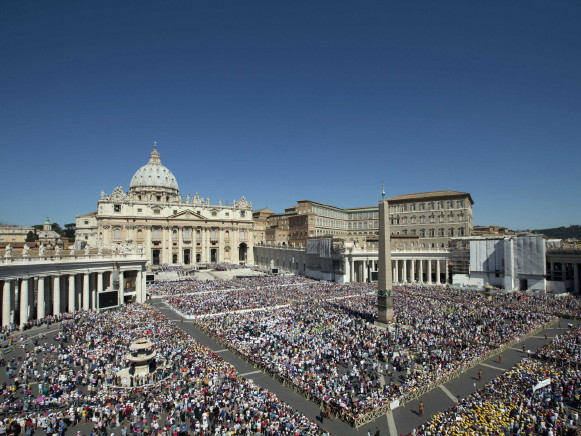Vatican
Vatican. A city-state in Rome and the center of the Catholic church. It was recognized as an independent state under the terms of the Lateran Treaty of 1929 between the Italian government and the Holy See. It covers a territory of approximately 0.4 sq km and includes Saint Peter's Basilica, the papal palaces, the Vatican Library, Vatican Radio, a number of other buildings, and some properties outside the city (eg, Castel Gandolfo, the summer residence of the pope).
According to tradition, ties between the papacy and Ukrainian territory date from the 1st century, when the Roman emperor Trajan exiled Saint Clement I to Crimea. Clement died a martyr in Chersonese Taurica, and some of his relics were reputedly taken to Kyiv and deposited in the Church of the Tithes. After the adoption of Christianity in Kyivan Rus’ (see Christianization of Ukraine), Popes John XV (988 and 991) and Sylvester II (1000) sent emissaries to Kyiv, and Prince Volodymyr the Great sent representatives to Rome (991 and 1001). Bruno von Querfurt, while traveling on a mission to the Pechenegs ca 1006, visited Volodymyr in Kyiv. Prince Iziaslav Yaroslavych sent his son Yaropolk Iziaslavych to Rome in 1075 to enlist the help of Pope Gregory VII in his fight for control of Kyiv. Giovanni da Pian del Carpini headed a mission from Pope Innocent IV to the Mongols in 1245–7 and began negotiations with Princes Danylo Romanovych and Vasylko Romanovych that led to the 1253 coronation of Danylo by an apostolic delegate. In the 15th century the Kyivan metropolitan Isidore lived in Rome, and Yurii Drohobych published Judicium prenosticon Magistri Georgii Drogobicz de Russia, the first book written by a Ukrainian, there in 1483. It contained a dedication to Pope Sixtus IV.
A new era in Ukrainian relations with the Vatican began in 1595, when several Ukrainian and Belarusian bishops wrote to the Holy See to initiate the Church Union of Berestia. Since then there has been close contact between the Ruthenian or Ukrainian Catholic church and the Vatican. Many bishops and metropolitans (eg, Yosyf Rutsky, Rafail Korsak, Metodii Terletsky, Yakiv Susha) traveled regularly to Rome, which served as the legal center of the Halych metropoly following the destruction of the Catholic church in Ukraine in 1946. The Ukrainian Catholic church has been formally represented at the Vatican since 1626 by a procurator of the Kyivan metropolitan and Basilian monastic order, who was based at the Church of Saints Sergius and Bacchus from 1639 to 1880. Beginning with Yoakym Morokhovsky (1596) and Y. Rutsky (1599), many Ukrainians attended Saint Athanasius Greek College, founded in the mid-16th century to train Eastern church rite theologians. Over 50 Ukrainian Basilian theologians were educated in the international college of the Congregation for the Propagation of the Faith, which was responsible for the affairs of the Uniate church from 1622 until the creation of the Congregation for Eastern Churches in 1917. From 1845 Ukrainian Catholic priests were trained at the Greek College, which was called the Greek-Ruthenian College until 1897, when Pope Leo XIII sanctioned the establishment of Saint Josaphat's Ukrainian Pontifical College. The college was based near the Church of Saints Sergius and Bacchus until 1932, when Pope Pius XI had a new building constructed outside the Vatican, and the original premises became a study center for the Basilian order. In the 1960s the building came to house the parish offices and a museum of Ukrainian art.
In addition to these older bodies, several other institutions of the Ukrainian Catholic church were moved to the Vatican after the liquidation of the church in Ukraine, or established there or near there since then. These include the headquarters of the Sisters Servants of Mary Immaculate and of the Basilian order of nuns, the Ukrainian Minor Pontifical Seminary, the Studite Monastery in Castel Gandolfo, the Ukrainian Catholic University (Rome), and Saint Sophia's Church. Important Ukrainian church figures (or their relics) are buried at the Vatican, including Saint Yosafat Kuntsevych (in Saint Peter's Basilica), Rafail Korsak (in Saints Sergius and Bacchus Church), and Yosyf Sembratovych (in the crypt of Saint Sophia's Church).
The Vatican library and archives contain many documents and monuments relating to Ukraine. These include papal correspondence concerning Ukrainian affairs, beginning with letters from Pope Gregory VII to Prince Iziaslav Yaroslavych from 1075. There are also many reports and documents from papal nuncios in Poland and elsewhere who were charged with gathering information for the Vatican. The archives of the Congregation for the Propagation of the Faith and the Congregation for Eastern Churches are especially rich in these materials, as are the holdings of the Greek College and the various monastic orders or congregations. Many of the first works dealing with the history of the Ukrainian church to be published abroad (eg, biographies of Yosafat Kuntsevych [1643] and Yakiv Susha [1665] and I. Kulchytsky’s outline history of the Ukrainian Catholic church [1733–4]) were published at the Vatican, and major series of Vatican documents pertaining to Ukraine were initiated in the 19th century and especially in the interwar period. These resources and the other notable structures at the Vatican have attracted Ukrainian scholars and artists, and other Ukrainians, since the 18th century.
The Vatican has been the site of several conclaves of Ukrainian bishops (held in 1929, 1932, 1955, and regularly since the late 1960s), and since 1946 the apostolic visitator for Ukrainians in Western Europe has been based there. (See also Vatican-Ukrainian diplomatic relations.)
[This article originally appeared in the Encyclopedia of Ukraine, vol. 5 (1993).]

